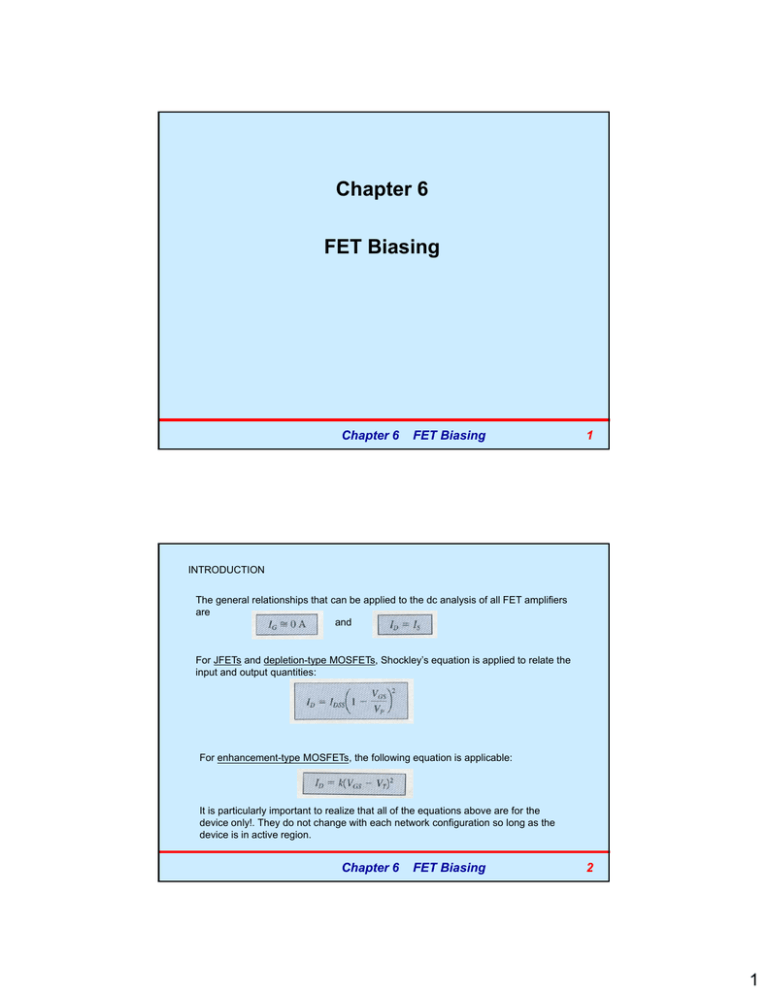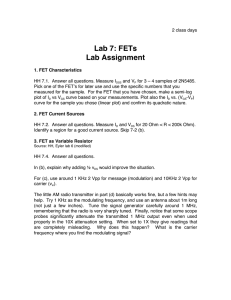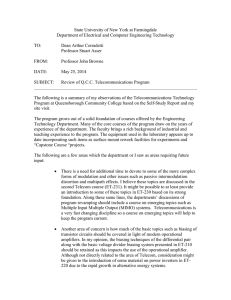Chapter 6 FET Biasing
advertisement

Chapter 6 FET Biasing Chapter 6 FET Biasing 1 INTRODUCTION The general relationships that can be applied to the dc analysis of all FET amplifiers are and For JFETs and depletion-type MOSFETs, Shockley’s equation is applied to relate the input and output quantities: For enhancement-type MOSFETs, the following equation is applicable: It is particularly important to realize that all of the equations above are for the device only!. They do not change with each network configuration so long as the device is in active region. Chapter 6 FET Biasing 2 1 (A) FIXED-BIAS CONFIGURATION Vi&Vo:input & output ac levels C1&C2: the coupling capacitors (open for dc analysis & low impedance (essentially short circuit) for ac analysis. For dc analysis; The zero-volt drop across RG permits replacing RG by a short-circuit equivalent, as appearing in the network redrawn for the dc analysis. Chapter 6 FET Biasing 3 The fact that the negative terminal of the battery is connected directly to the defined positive potential of VGS clearly reveals that the polarity of VGS is directly opposite to that of VGG. KVL in the clockwise direction will result in Since VGG is a fixed dc supply, the voltage VGS is fixed in magnitude, resulting in the notation “fixedbias configuration”. The resulting level of drain current ID is now controlled by Shockley’s equation. Since VGS is fixed quantity, its magnitude and sign can simply be substituted into Shockley’s equation and the resulting level of ID calculated. Here, a mathematical solution to a FET configuration is quite direct. Chapter 6 FET Biasing 4 2 On the other hand, graphical analysis would require a plot of Shockley’s equation. Recall that choosing VGS=VP/2 will result in a drain current of IDSS/4 when plotting the equation. IDSS/2 O.3VP In this analysis, four points defined by IDSS, VP and intersection will be sufficient for plotting the curve. Chapter 6 The fixed level of VGS has been superimposed as a vertical line at VGS = -VGG. The quiescent level of ID is determined by drawing a horizontal line from the Q-point to the vertical ID axis. FET Biasing 5 Once the network is constructed and operating, the dc levels of ID and VGS that will be measured by the meters are the quiescent values. The drain-to-source voltage,VDS of the output section can be determined by applying KVL; Recall that single-subscript voltages refer to the voltage at a point with respect to ground. Using double-subscript notation: Chapter 6 FET Biasing 6 3 Example (1): Determine the following. Solution: Mathematical Approach Chapter 6 FET Biasing 7 Graphical Approach: IDSS/2= 5mA The resulting Shockley curve and the vertical line at VGS = -2V are provided in the figure. It is certainly difficult to read beyond the second place without significantly increasing the size of the figure figure, but a solution of 5.6mA from the graph is quite acceptable. (a) 0.3VP The results clearly confirm the fact that the mathematical and graphical approaches generate solutions that are quite close. Chapter 6 FET Biasing 8 4 (B) SELF-BIAS CONFIGURATION The self-bias configuration eliminates the need for two dc supplies as required for fixed-bias configuration. The controlling gate-to-source voltage, VGS is now determined by the voltage across a resistor RS introduced in the source leg of the configuration. For the dc analysis, the capacitors can again be replaced by “open circuits” and the resistor RG replaced by a shortcircuit equivalent since IG = 0A. Chapter 6 FET Biasing 9 The current through RS is the source current IS, but IS = ID and For the indicated loop, we find that Note that VGS is a function of the output current ID and not fixed in magnitude as occurred for the fixed-bias configuration. The mathematical solution could be obtained simply by substituting the above equation into Shockley’s equation as shown below; Chapter 6 FET Biasing 10 5 Graphical Approach: First, st, tthe e ttransfer a s e ccharacteristics a acte st cs a are e de defined ed us using g 4 po points ts tec technique. que Then, a straight line has to be defined on the same graph by identifying two points. Point (1); The most obvious condition to apply is ID = 0 A since it results in VGS = -IDRS =(0 A) RS = 0 V. Therefore, the first point is ID = 0A and VGS = 0V. Chapter 6 FET Biasing 11 Point (2): For example, we choose a level of ID equal to one-half the saturation level. The straight line is drawn using the above two points and the quescient point obtained at the intersection of the straight line plot and the device characteristic curve curve. The quescient values of ID and VGS can then be determined and used to find the other quantities of interest. The level of VDS can be determined by applying KVL to the output circuit. In addition; Chapter 6 FET Biasing 12 6 Example (2): Determine the following. Using 4 points technique Define 2 points bias line Basic equation; Example: Chapter 6 FET Biasing 13 Chapter 6 FET Biasing 14 (a) 7 (C) VOLTAGE-DIVIDER BIASING The voltage-divider bias arrangement applied to BJT transistor amplifiers is also applied To FET amplifiers. The basic construction is exactly the same but the dc analysis of each is quite difference. IG = 0A for FET amplifiers, p but the magnitude of IB for common-emitter BJT amplifiers can affect the dc levels of current and voltage in both the input and output circuits. Recall that IB provided the link between input and output circuits for the BJT voltage-divider configuration while VGS will do the same for the FET configuration. The network can be redrawn as shown in the next slide for the dc analysis. Note that all the capacitors, including the bypass capacitor CS, have been replaced by an “open-circuit” equivalent. In addition, the source VDD was separated into two equivalent sources to permit a further separation of the input and output regions of the network. Chapter 6 FET Biasing 15 KCL requires that IR1 = IR2 and the series equivalent circuit appearing to the left of the figure can be used to find the level of VG. The voltage VG, equal to the voltage across R2, can be found using the voltage-divider rule as follows: KVL in the clockwise direction to the indicated loop will result in and substituting we have The procedure for plotting the above equation is not a difficult one and will proceed in the next slide. Chapter 6 FET Biasing 16 8 Since any straight line requires two points to be defined, first we can use the fact that anywhere on the horizontal axis, the current ID = 0 mA. Therefore, select ID to be 0 mA, we are stating that we are somewhere on the horizontal axis. The exact location can be determined by substituting ID = 0 mA into the previous equation and finding the resulting value of VGS as follows: Point No.1 The result specifies that whenever we plot the above equation, if we choose ID = 0 mA, the value of VGS for the plot will be VG volts. For the other point, let us employ the fact that at any point on the vertical axis VGS = 0 V and solve for the resulting value of ID: Point No.2 Chapter 6 FET Biasing 17 The two points defined in the previous slide permit the drawing of a straight line line. The intersection of the straight line with the transfer curve in the region to the left of the vertical axis will define the operating point and the corresponding levels of ID and VGS. Chapter 6 FET Biasing 18 9 Since the intersection on the vertical axis is determined by ID = VG/RS and VG is fixed by the input network, increasing values of RS will reduce the level of the ID intersection as shown in the figure. It is fairly obvious that: Increasing values of RS result in lower quiescent values of ID and more negative values of VGS. Chapter 6 FET Biasing 19 FET Biasing 20 Once the quiescent values of IDQ and VGSQ are determined, the remaining network analysis can be performed in the usual manner. That is, Chapter 6 10 Example (3): Determine the following. Chapter 6 FET Biasing 21 FET Biasing 22 Example (4): Determine the following. Chapter 6 11 DEPLETION-TYPE MOSFETs The similarities in appearance between the transfer curves of JFETs and depletion-type MOSFETs permit a similar analysis of each in the dc domain. The primary difference between the two is the fact that depletion-type MOSFETs permit operating points with positive values of VGS and levels of ID that exceed IDSS. In fact for all the configurations discussed thus far, the analysis is the same if the JFET is replaced by a depletion-type MOSFET. The only undefined part of the analysis is how to plot Shockley’s equation for positive values of VGS. How far into the region of positive values of VGS and values of ID greater than IDSS does the transfer curve have to extend?. For most situations, this required range will be fairly well defined by the MOSFET parameters and the resulting bias line of the network. Chapter 6 FET Biasing 23 FET Biasing 24 Example (5): Determine the following. Chapter 6 12 Example (6): Repeat Example (5) with RS = 150 Ohm. Example (7): Determine the following. Chapter 6 FET Biasing 25 Chapter 6 FET Biasing 26 Example (8): Determine VDS. 13 ENHANCEMENT-TYPE MOSFETs Note: The transfer characteristics of the enhancement-type MOSFET are quite different from those encountered for the JFET and depletion-type MOSFETs, resulting in a graphical solution quite different from the preceding sections. Recall that for the n-channel enhancement type MOSFET, enhancement-type MOSFET the drain current is zero for levels of gate-to-source voltage, VGS less than the threshold level VGS(Th). For levels of VGS greater than VGS(Th), the drain current is defined by Transfer characteristics of n-channel E-MOSFETs Chapter 6 FET Biasing 27 Since specification sheets typically provide the threshold voltage and a level of drain current ID(on) and its corresponding level of VGS(on). To draw the characteristics curve, the constant k mentioned in the previous equation must be determined from the specification sheet data by substituting ID(on) and VGS(on). into that equation. Once k is defined, other levels of ID can be determined for chosen values of VGS. Typically, a point between VGS(Th) and VGS(on) and one just greater than VGS(on) will provide a sufficient number of points for the plotting. Chapter 6 FET Biasing 28 14 (i) Feedback Biasing Arrangement A popular biasing arrangement for enhancement-type MOSFETs is provided in the figure. The resistor RG brings a suitably large voltage to the gate to drive the MOSFETs “ON”. Since IG = 0 mA and VRG = 0 V, we can draw the dc equivalent network. Chapter 6 FET Biasing 29 A direct connection now exists between drain and gate, resulting in For the output circuit, circuit Then, it also become Network equation or straight line equation A procedure as previously described can be employed to draw a straight line by determining the two pints that will define the plot on the graph. Chapter 6 FET Biasing 30 15 Substituting ID = 0 mA; Substituting VGS = 0 V; Chapter 6 FET Biasing 31 FET Biasing 32 Example (9): Determine IDQ and VGSQ. Chapter 6 16 (ii) Voltage-Divider Biasing Arrangement A second popular biasing arrangement for the enhancement-type MOSFETs. The fact that IG = 0 mA results in the following equation for VGG as derived from the application of the voltage-divider rule. Applying KVL around the indicated loop will result in For the output section; Once IDQ and VGSQ are known, all the remaining quantities such as VDS, VD and VS can be determined. Chapter 6 FET Biasing 33 FET Biasing 34 Example (10): Determine IDQ , VGSQ.and VDS. Chapter 6 17




